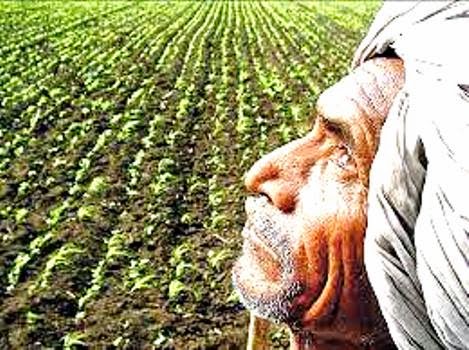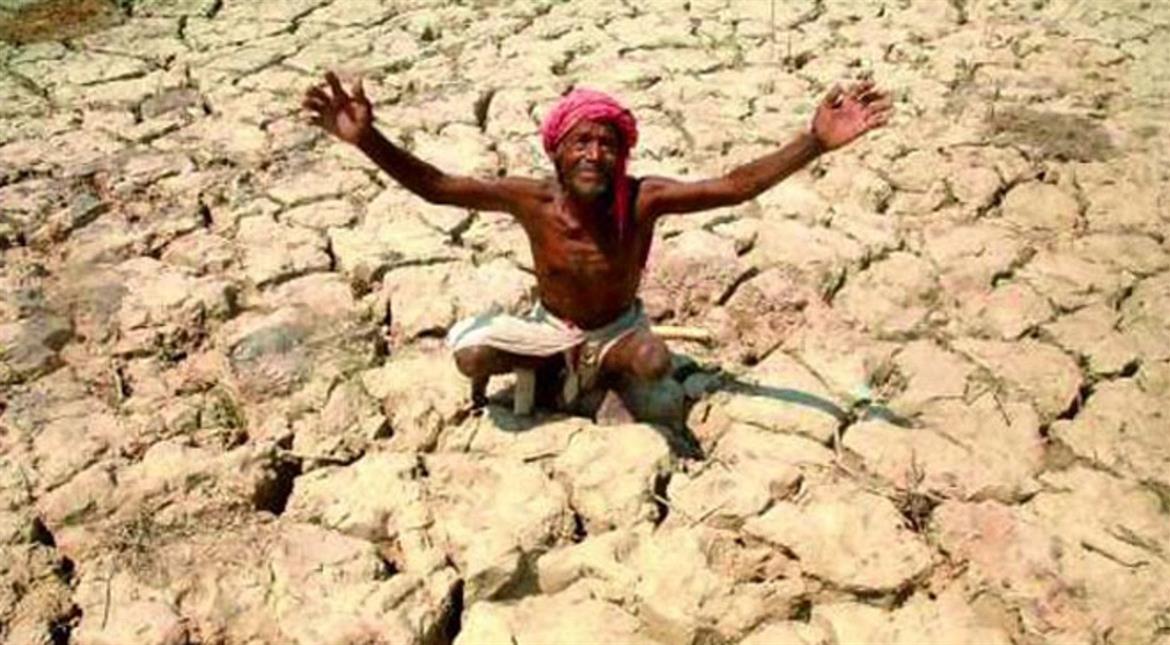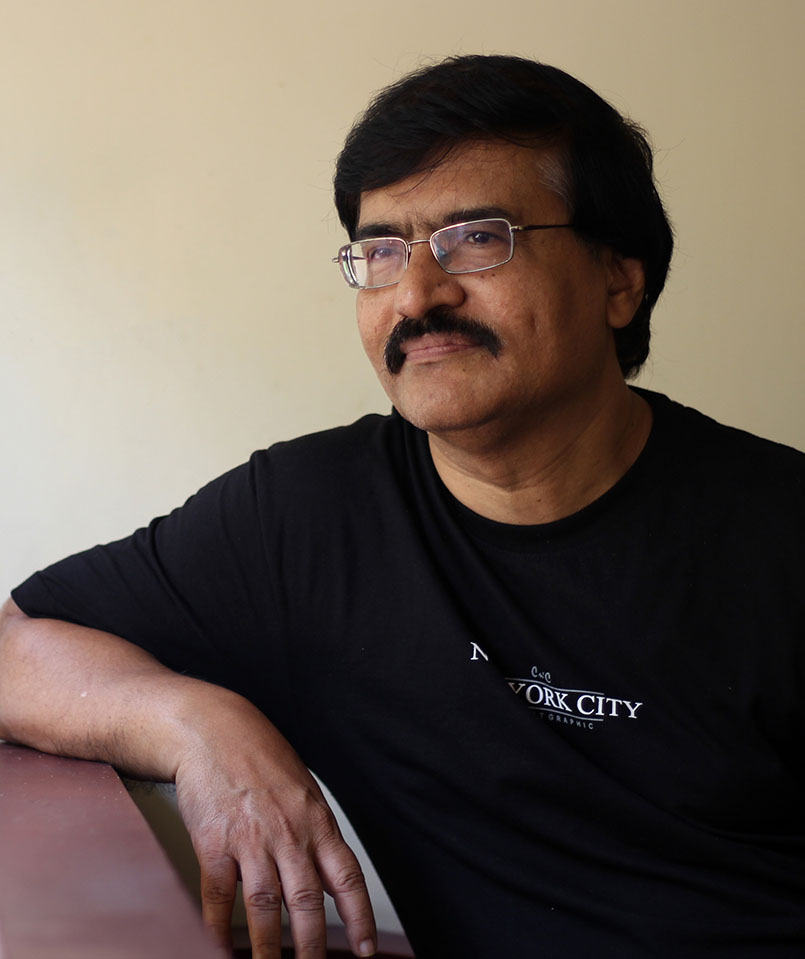He had hailed from Dausa in Rajasthan. Some say he was a poor farmer. Others say that he was quite well off. Some say he was distressed after his crops were damaged in the unseasonal rains and hailstorm. Others say he was no way in any distress. An alleged suicide note found in his pocket says that he was disowned by his family and driven out of his home. His family denies it and raises doubts about the bona fides of the ‘suicide note’. Some say he was in touch with a promine nt AAP leader in Delhi. AAP says there was no such contact or communication with the person. Thus, we heard many things about him. But we are not sure of most of what we heard. The only thing we know for sure is that Gajendra Singh is dead.
nt AAP leader in Delhi. AAP says there was no such contact or communication with the person. Thus, we heard many things about him. But we are not sure of most of what we heard. The only thing we know for sure is that Gajendra Singh is dead.
Gajendra Singh had come to Delhi to participate in the farmers’ rally organized by the Aaam Aadmi Party (AAP) at Delhi’s Jantar Mantar on 22 Mar 2015. The rally was against the new Land Acquisition Ordinance issued by the Modi Government. Although Gajendra Singh died, the Government’s Land Acquisition Ordinance 2015 is very much alive.
It is an accepted fact that some 60-65 per cent of our citizens are dependent on agriculture for a living, either as landowners or as farm labour. Around 85% of these farmers fall into the small and marginal category. For want of irrigation, 65% of our farming is ‘rain-fed’ and hence wholly open to the vagaries of the weather. Our farmers are now passing through a period of unprecedented crisis. The rulers often seem to think that sheer drama and rhetoric would end the country’s agrarian distress and eradicate poverty and hunger from its face. When the sole focus of the government with the so called ‘development agenda’ is on the GDP numbers and it tinkers with the GDP computations to make it look seductive, it will have little time left to bother about our farmers – living or dead. Reports say that nearly three lakh farmers killed themselves in the last two decades. And the number of farmer suicides vaulted by 26% in the year 2014.
For all the crocodile tears that politicians shed for the rural poor, the total budgetary allocation for rural development in the current year budget is the lowest in the past three years. The current year’s allocation for rural schemes is Rs 79,526 crore. This is five per cent lower than last year’s allocation of Rs 83,852 crore. The budgetary allocation for the Mahatma Gandhi National Rural Employment Guarantee Scheme (MGNREGS) this year is Rs 34,700 crore. It was Rs. 34,000 crore last year. The Parliament was told by the Prime Minister that he wanted to keep this scheme alive with enough funds as a memorial of the lack of concern of the previous regime for the rural poor who were engaged in digging pits (khadda khodne). The comment evoked derisive laughter and thunderous applause from the treasury benches. I do not know whether people have since stopped digging pits. The PM’s views notwithstanding, the World Bank now says that it has been the only insurance for the rural poor in India and must be strengthened. But in 2014-2015 (under the BJP regime), these people were not paid their wages to the tune of Rs. 4,350. So the actual allotment for the rural employment scheme in 2015-2016 works out to Rs 30,000 crore, which is Rs.4,000 crore less than last year’s allocation!
I would not like to burden the reader with more statistics. The long and short of it is that in the case of almost every agricultural and rural development schemes, the budgetary support is much lower this year. But at the same time, government abolished wealth tax and proposed to bring down corporate tax from 30% to 25% in the next five years. It was reported that every one percent tax reduction for corporates would mean that the government would give up Rs.20,000 crores a year. Thus in the next five years, the public exchequer will lose an estimated Rs 20,000+40,000+60,000+80,000+100,000=300,000 crores. Yet, there was hardly any worthwhile relief for the individual taxpayer. And the service tax, that pinches every purse, was quietly raised to 14%. The government has really taken the common man for a ride.
The Prime Minister says that all previous Congress governments were head over heels in love with poverty. He alleges that it was part of their evil agenda to keep people poor so that they would survive on government doles and vote en masse for the dole givers. The new Land Ordinance is his magic wand to alleviate all the miseries of the rural poor. And the Prime Minister claims that this new piece of legislation is the panacea for all of India’s agrarian distresses. Once the new Act comes into force, farmers would no more be tilling their lands. They would be lifted up and put in to the cosy seats of the corporate heavens. He tells the nation’s farmers that anyone speaking against the changes made in the previous government’s Land Acquisition Act is the sworn enemy of the farmer.
For a change, the Prime Minister seems to be right in one thing. The farmers would no more be tilling their lands. With the new Land Acquisition Law, most farmers would be left with no land to till. It would all be taken away by the government to please the corporates. The new Ordinance has done away with seeking the farmer’s consent before taking away his land. The landowners will have no right to question the taking over of his land. As Alfred Lord Tennyson puts it in his famous poem, “Theirs not to reason why, Theirs but to do and die…” As regards the promise of elevating all farmers into the comforts of corporate jobs, your guess is as good as mine. Nevertheless, we will examine here, how the new Land Ordinance tilts the equations so heavily against the Indian farmer. Please take a look and decide for yourself whether the changes made are really meant for the welfare of the farmer.
The Land Acquisition Act 2013 was an attempt to correct the arbitrariness inherent in the Land Acquisition Act of colonial vintage that India had been operating for over a century. The Parliament committee that examined the 2013 Bill of UPA government was headed by Ms Sumitra Mahajan from BJP, who is currently the Hon Speaker of the Lok Sabha. It was a tedious job for her to bring opinions around to evolve a consensus to get the bill cleared with the support of more or less all the parties in Parliament including the BJP. Incidentally, the law has not been tested for its viability or otherwise so far. Most states have not even notified it. Yet, the new NDA government under the leadership of Sri Narendra Modi wanted to make changes to that Act. When the opposition objected to some of the changes proposed by the government, it took the Ordinance route to scuttle the objections. When a second attempt to get the changes approved by the Parliament too failed, the Ordinance was re-promulgated in 2015.
Now, let us compare a few critical changes being implemented by the present government to the provisions of the 2013 Land Act to understand to what extent the hearts of our rulers have been bleeding for the farmers.
1.The Land Acquisition Act 2013 had made it mandatory to obtain the consent of the landowner before land was acquired under the Act when the acquisition is for purely private or Public-Private-Partnership (PPP) projects. When land acquisition wholly for private project, it was necessary to obtain the consent of 80% of the landowners. Acquisition of land for PPP Projects needed consent of 70% of the landowners. It was also necessary to do Social Impact Assessment (SIA) and Environmental Impact Assessment (EIA) prior to acquiring the land in both cases.
The Ordinance now issued has changed the entire perspective of the Act in its former form. The critical question for land acquisition under the 2013 Act was ‘whose project’ meaning whether the proposal is for a Government, PPP or Private project. In the new Ordinance, the critical question is ‘what project’, meaning whether the project falls into any of the categories eligible for ‘special treatment’ under the Act.
The new Land Ordinance says that projects falling under any of the following five categories are exempt from owners consent.
- Defence and defence production
- Rural infrastructure (including rural electrification)
- Affordable housing
- Industrial corridors
- Social infrastructure projects including PPPs in which land ownership rests with the government
Such projects could also receive exemption from Social Impact Assessment (SIA).
All projects, whether government, PPP or private, will be exempt from landowner consent and SIA clauses if it can be made to fit under any of the above five categories.
The problem with the amendment is that the categorizations are done in such a way that almost all conceivable projects can be accommodated against one of these categories. (Some examples of the types of projects eligible for ‘special treatment’ are roads, bridges, airports, ports, inland waterways, electricity generation, electricity transmission, power distribution, gas pipelines, oil pipelines, water supply pipelines, storm water drainage, telecommunication, telecommunication towers, education, hospitals, three-star or higher category hotels, special economic zones, tourism facilities, terminal markets, post-storage infrastructure, industrial corridors, mines, water conservation, agro-processing and national security …) As someone asked, what is now left out of special treatment Sir? Wild Life Sanctuaries!?
2. The Land Acquisition Act 2013 had imposed restrictions on the acquisition of irrigated multi-cropped land. The new ordinance removes this restriction so that the government would be in a position to acquire land for even private projects without any regard whatsoever for the type of land.
In an interview on the Times Now TV channel the other day (Frankly Speaking, 26.04.2015), Finance Minister Arun Jaitley was heard saying that a substantial part of the land would be used for irrigation projects. As a layman, I fail to understand the logic of acquiring irrigated multi-croppedland for ‘irrigation projects’!
3. The Land Acquisition Act of 2013 had prescribed that in case the land acquired was not utilized for the purpose for which it was acquired, for five years after acquisition, the land will be returned to the original owners or to the land bank.
The Ordinance of 2015 changes it to say that the period after which unutilised land will be returned will be five years, or any period specified at the time of setting up the project, whichever is later. This would mean that land could be acquired and kept for any length of time by clever manipulation. You can keep the land take all the time in the world to execute the project.
A worrying aspect of this change is that the government has now promised employment to one person from the family giving up their land for the project. When would this person get the job promised when there is nothing certain about the period of completion of the project? How will the family survive until then when their land too is taken away?
4. Land for private hospitals and private educational institutions could not be acquired under the Land Act 2013. (Such acquisition would be through private deals outside the purview of the act.) The new Ordinance has removed this restriction.
5. The Land Acquisition Act of 2013 had prescribed that the law would apply only for acquisition of land for private companies. But the Ordinance has changed the term ‘private companies’ as ‘private entities’. A private entity is an umbrella term that would cover proprietorship, partnership, company, corporation, non-profit organisation, or other entity under any other law. In other words, any Tom, Dick and Harry would be able to take away any land without landowner consent.
6. In the Land Acquisition Act 2013, there was a provision to make government servants accountable for the offences committed under the Act. It had stated that the Head of the Department would be deemed guilty unless it was established that the offence occurred outside his knowledge or in spite of his exercising due diligence to prevent the commission of the offence.
The new Land Ordinance replaces this provision to say that if an offence is committed under the Act, the government servant cannot be proceeded against without the sanction of the government.
I believe that anyone with an objective mind would see that the changes now brought in to the Land Acquisition Act 2013 are solely meant to rob the poor farmers’ land to fatten the rich with no questions asked by the landowner or anyone else. The Ordinance changes hardly anything for government/public projects, which enjoyed ‘special treatment’ even under the earlier Actl. The focus of the Ordinance is entirely on Private projects. Very few of the farmers are conscious of this fatal trap. Some prominent farmer leaders too have started endorsing the changes for reasons best known to them. The sugar coating of four times the market price etc. (which was already there in the previous Act too) should not entice the farmer since land prices rise by leaps and bounds. (For instance, the price of the property on which I now live has increased over a 100 fold in the course of the last 25 years).
The whole story that farmers are itching to get out of farming is a myth. When the government refuses adequate support price to the fruits of his labour, impose steep increases in the prices of fertilizers, and deny minimum credits for him to go on and drastically cuts the budgetary support for him, the farmer would be driven to desperation and give up his land under duress (and might eventually give up his life too although for the government, it would not count as a farmer suicide!) In any case, if the farmers wish to give up farming, getting their consent should present no problems. Then resolve the major worry my simply restoring the consent clause Sir.
Sri Arun Jaitley is one of the few Indian politicians I still respect. In the interview mentioned above, he said that the 60% of Indian farmers contributed just 15% to the nation’s GDP. Half of them are farm labour that did not own land. So they would not be affected by the proposed changes in the Land Acquisition Act 2013. For the rest, farming is a losing proposition. So it was necessary for his government to take them out of farming and put them in to industry. Unlike the past governments, the present government does not want the poor farmers to live and die as poor farmers forever. The government wants to transform the rural poor into the urban rich. Anyone listening to the Finance Minister would fall for the charm and force of his words and his professed concerns for the uplift of the poor farmer. The sum and substance his arguments is, ‘just give us your lands and we will give you Acche Din’(Good Days).
But pray, what are the ground realities? How many new jobs have been created by the industry since the new government took over nearly a year ago in May 2014? How many projects have been stalled for want of land? Reports say that in Madhya Pradesh alone, some 60,000 odd hectares of acquired land is remaining unutilized. How much foreign investment has come into India in the last one year because of the highly hyped foreign jaunts of the PM? Reports say that the investment proposals that emerged out of the ‘Make in India’ German campaign this time was much less than what India was able garner in its previous such outing.
Also, to what extend has manufacturing been growing? During the Prime Minister’s latest France visit, we have decided to buy three dozen ready to fly (in ‘flyaway’ condition) fighter planes from a French company facing closure because of a blank order book. Its production capacity is just 12 fighters a year. It is a government-to-government deal. Why such a deal when the same people cried foul and stalled defence procurements under the previous regime. Then everyone clamoured for global tenders. Some seven odd years of hard work went into the shortlisting of the fighters. Now, suddenly an impression has been created that our highly dynamic PM just flew into Paris and returned with three dozen fighters under his belt.
How does the French fighter deal help the ‘Make in India’ mission of the PM? How does it help the PM’s oft-articulated vision of India’s domestic defence productions and defence hardware exports? Dr Subramanian Swamy, a staunch BJP supporter, says in an interview to Outlook, “No country outside France has so far bought the Rafale. Some countries had shortlisted it, but rejected it later. We must find out why they did so. We must also know why it is so much more expensive than the other competitors. With the kind of money India has pledged to buy the planes, it can actually buy over the entire company that makes them. Moreover, there are also reports that it is trying to win the contract by giving a subcontract to an influential Indian industrialist…”
I would never forget my childhood days when we used to see white sacks of grain and floor on which it was written in bold black letters, ‘Donated by the People of the United States of America’. Probably, that was the first English line I had read outside my textbook. For a long time after Independence, India did not produce enough food for its ever-growing population. Then we faced a devastating border war with China. We survived on foreign charity. It was a humiliating life. But the Green Revolution changed it all and transformed India from a starving nation to a nation that exported food grains. Our granaries overflowed. The visionary leadership of India had planned and executed it, although there is currently a conscious and motivated attempt to discredit and malign it. An editorial piece of The Hindu daily today (28.04.2015) starts as follows, “Everything else can wait but agriculture cannot, said Jawaharlal Nehru. This should have been the talisman for India’s progress”. The farmers of India toiled to fill our food plates. They still sweat it out on the soil to do so. All the while, the farmer’s life has been one of sweat, pain and penury. We now want to take away his land, no questions asked!
I grew up in a farming family. I worked in the soil part of the day during my young years. I had experienced the hard life of the rural farmer. My own father was one. So, the misery of the farmer touches me. It should touch every one who respects the food he eats. A ‘click of the mouse’ does not produce rice, wheat and sugar. Successive governments have ignored the plight of the farmer. And finally now we want to relieve the farmer of all his miseries and give him ‘Acche Din’ by simply grabbing his land to serve it on a platter to the rich and fat. Where will our three, four or five square meals come from then? Of course, we can import everything. The opinion makers in their ‘suits and boots’ would not mind if it costs more. Yes, starting from the vey top, we now have a newfound love for everything international. As Shiv Visvanathan writes in The Hindu dated 23.04.2015, “He (Modi) looked almost reluctant to be in India after the highs experienced after visiting Europe and Canada… After the exciting NRI engagements, India almost seems banal and disappointing to him…”
Let me now close. Who cares for the rural poor except for their votes? Who cries for Gajendra Singh except for his three innocent children? Whose heart bleeds for the thousands of indigent farmers killing themselves for want of an alternative, except for their close families?
May their souls rest in peace…












Sir,
This is the wonderful writing. You have simply touched all the plight of the farmers. Great
Happy to know that you like it. Thanks for your interest and support.
Only a person who has experienced the miseries of a famer can react against the injustice. W rite in paper to have more viewers. Let's all react against the injustice.
write
Thanks for you comment and support. I wonder any paper would publish such material considering its length and anti-establishment content. Let us see…
What you write makes a good reading. The problem however lies elsewhere and it is in being too emotional and falling prey to Jairam economics. Lets see some hard facts- %age of total land under agriculture in India is 61.4, average size of holding per person is 0.2 hectares and out of the total arable land only 3.1 % is under permanent crops. This when the size of Agri population has increased from 140 million in 51 to 402 million in 2001 and out of this only 32% are cultivators while the rest are either agri labour or other workers.SO the first decision we need to make that do we want these 32% cultivators command the Land and eat its fruits too and continue to remain a lopsided agrarian economy.
Further we have talked about the land falling prey to the BIG INDUSTRIALISTS- the question is where will the industries be establised if not on land and can we look forward to a life without industries. Are we ready to go back and till the land , grow our food and eat it too- if yes so be it.
Now the question the compensation being four times and the cost of land rising 100 times: why did it rise 100 times- simple economics say because of demand. Why was the demand caused- because of the increase in urban population. Why did the urban population increase- because some thought that life in village and dependance on agriculture is non remunarative. Who will pay 100 times the cost- people who live in cities and are employed in industries.
It is not that agriculture is bad. But too much population dependant on agriculture is bad. It stunts the growth both of agriculture and the Nation.
Now coming to the MGNREGA: this scheme was like the old Nawab schemes of employ people to first dig the well and then again to fill it up. Atleast the intention there was good to save the people from drought(only in drought years). Howevr the MGNREGA has helped more siphoning of money than any other scheme of Government. Huege amounts have flown in the States but not a single infrastructure has been created.(because MGNREGA quite surprisingly does not mandate this!!!!) Had this money been used to build roads and other infrastructure in rural areas the cause would have been better served. But no! the purpose was BUY VOTES and not IMPROVE LIFE.
So how does the LAA fair: It is required to help the Indian Farmer and Indian economy. The long debate of Industrialist vs the poor citizen has already lost all its relevance and now some new JARGONS need be discovered.
I Fest my case!
I thank you for your rather lengthy and well-argued comment. I am happy that, perhaps, for the first time someone (Anonymous) has been frank enough to record a perspective disagreeing with the one I have expressed in the post. I appreciate the intellectual honesty of the person. (I hate to make a guess with regard to the identity of the person) All of us have realize that everything is not either white or black. There is a lot of grey in between. I am not against industrialization. I am only against the changes that seek to ignore any involvement of the landowner while taking away his land. Of course, some emotional echo cannot be avoided when something I own and have been tending for generations is taken away with no questions asked. The four-fold compensation proposal was already in the previous bill. It has already been clarified from the side of the government that the land taken from industrial corridors will be owned not by the government but by those who would set up the industry on that land. That ownership would mostly be with any private 'entity'. There is much hidden in the vocabulary of the new act. I am of the view that the new land act is fraught with huge scope for interpretation, which would serve the interest of neither the farmer nor the public. At least it is difficult for me to appreciate the need for arbitrarily taking away multi-crop irrigated land to set up industries. I am not missing the point that under previous law, it was extremely difficult to get land for industrial needs. But under the new act, it is too easy to take away any land in almost an authoritarian way on the assumption that the government alone knows what is best. The majority in Parliament does not necessarily represent the will of the majority of citizens. Both opposition and government have to come down on their current positions in the best interests of the nation. It is not easy for many of us to step into the shoes of the poor and experience where it hurts. The suffering of the urban poor around us should teach us that urbanization may not be the panacea for ending rural poverty. The cure may be more injurious than the malady. I thank you once again for your valuable (differing) view.
Regards,
VGKutty